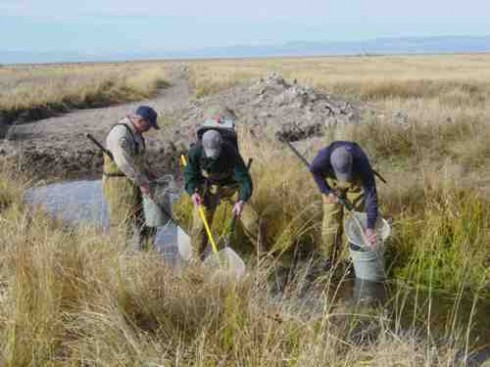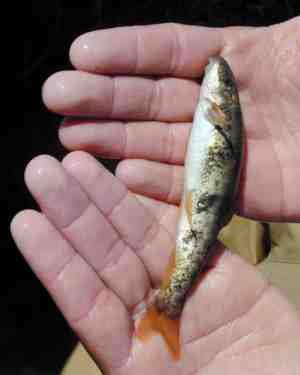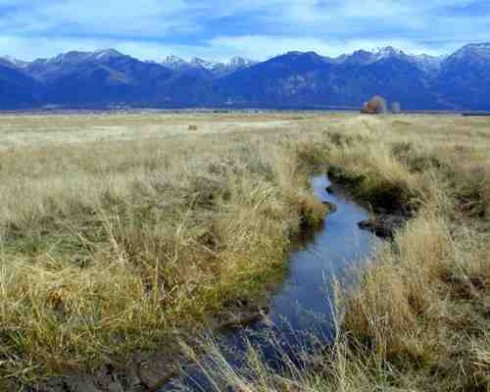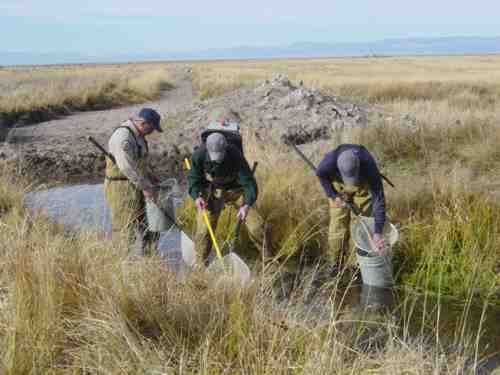Article by Shanna Lewis
Wildlife – May 2007 – Colorado Central Magazine
THERE ISN’T ONE BORN every minute, but things are looking up for a few suckers in the San Luis Valley — the Rio Grande Sucker fish. Once abundant, the numbers of these little brown Colorado native fish deteriorated so much, they were placed on the state endangered species list in 1993.

Since then, Division of Wildlife biologist John Alves has been working to preserve and grow the last remaining populations of the inconspicuous algae eating fish. These fish are found nowhere else in the world besides the Rio Grande river drainage in Colorado and New Mexico. Human activities have been hard on the suckers, which grow up to four to six inches in length. “In this age of irrigation, diversion of water and fragmentation of habitat, it’s hard to find a place, a stream that still has native fauna intact,” said Alves. Introduction of non-native species like white suckers and northern pike, plus destruction of habitat were part of a nearly fatal equation for the native fish.
During the last year and a half there have been a few positive additions to that equation. The first came in the fall of 2005, when Alves and two assistants splashed through the cold waters of Crestone Creek in the newly designated Baca National Wildlife Refuge in the San Luis Valley, netting and counting fish. As they surveyed the twisting channels that flow from the rugged Sangre de Cristos and cut through acres of grasslands on the Valley floor, they discovered a previously unknown population of Rio Grande suckers. This was an unexpected boon for Alves’ work and he was pretty happy about it. “We’ve been struggling over the last ten years to keep the populations growing in Colorado, so it doesn’t become a federally listed fish,” he said.
The good news continued last fall when the DOW team took their buckets, nets and scales and headed further upstream on Crestone Creek to inventory fish. Much to Alves’surprise they found more Rio Grande Suckers higher up in the drainage. Water levels had been low during periods of drought, so no one knew if the fish could have survived in those sections of creek. Alves said, “I’ve always wondered what was over here on this big tract of land. When it was private we didn’t have access, now that it’s public we’re exploring and seeing what we can find.”
Part of the DOW’s efforts to increase the numbers of Rio Grande suckers includes a breeding program at its Native Aquatic Species Hatchery in Alamosa. It wasn’t easy getting the fish to reproduce and survive in captivity though. Hatchery manager Dave Schnoor said, “By 2003 we were getting eggs produced on a regular basis but when the fry hatched off they wouldn’t feed. They wouldn’t accept any food.”

Fresh, frozen, dried foods -nothing worked. But finally, last year they found the secret to getting the fish to eat. The water at the hatchery was too alkaline. A small change in pH, from about 8.8 down to 8.5 made a big difference. “They went on to feed immediately,” said Schnoor, “instead of getting three percent on feed, like we had the past two years, only about three percent didn’t go on feed.”
Now there’s a growing population of Rio Grande Suckers living in tanks fed by the maze of pipes at the hatchery. Several creeks around the Valley will be restocked with fish from the hatchery to help redevelop the native species. Alves continues to look for appropriate places to stock the fish. “Cottonwood Creek looks like a good bet,” he said.
Alves is pleased with the recent progress. “We’re starting to turn the corner on Rio Grande suckers,” he said. Yet he’s still cautious about his predictions for the future of the fish. Good water flow and quality in the creeks are vital to the survival of the fish and he’s working with the U.S. Fish and Wildlife Service, which manages the 92,000 acre refuge, to address these concerns.
According to Ron Garcia, the refuge manager, there are tentative plans to spend about $30,000 this year to install six to eight water control structures along Crestone Creek. These structures will allow them to divert water from the streams to irrigate nearby wetlands and still maintain appropriate levels in the creek for the fish. “Our first priority is to keep the water flowing in the creeks,” said Garcia.
Some 2,000 to 5,000 acres of wetlands will be irrigated with this water, benefitting wildlife on the refuge. There is an agricultural component to the management of these areas involving either grazing or haying but Garcia said, “It’s very tightly prescribed. We select permittees who are willing to operate within our parameters, which are designed primarily to keep invasive species down and keep optimal conditions for wildlife.”
Garcia also has another even larger challenge to contend with in his charge to protect the environment for the Rio Grande Suckers and other species on the refuge -an existing mineral right that doesn’t belong to the refuge. Lexam Explorations, a North American based energy exploration company, has already begun operations looking for oil and gas on the refuge. Garcia has been working closely with the company and its contractors to try to eliminate or alleviate potential long term damage to the refuge.
“I wish it weren’t happening here but I don’t have control over that,” he said, “The company has been very willing to work with me. Everything I’ve asked for they’ve given.”
He’s asked them to stay away from very sensitive riparian areas and to use methods that have the least impact on the environment. They agreed to a closed loop system where all of the by-products of exploration such as soil or waste water are contained in tanks, removed and disposed of off the refuge. He’s even asked them to work only at the coldest times when everything is frozen, so that the impact to soil and vegetation is lower. He said, “When daytime temperatures got warmer in February, I shut them down and asked them to only go at night after midnight. And they did.”

There’s another hurdle to overcome for the Rio Grande suckers, they have a bit of an image problem. “Most people don’t see them because they’re an inconspicuous fish on the bottom of the stream, so people think of them as bait or a species with no value,” said Alves. He spends some of his time educating people about the fish. His public relations activities include visits to area schools. “When I go to classes, I tell the kids that they’re born and raised in the San Luis Valley so that means they’re natives. These fish are the same as them. You can’t find these fish anywhere else in the world so it’s something pretty special to have a native fish that’s unique to right where they live,” he said.
Although there hasn’t been research into what would happen if the Rio Grande sucker were to become extinct, both Alves and Garcia stress the importance of keeping all the parts of an ecosystem intact. “We know if the conditions are right for the Rio Grande sucker, that conditions are right for a lot of other species that depend on similar habitats,” said Garcia.
Alves uses the metaphor of a mechanic putting a complex machine like a helicopter together to describe the value of protecting native species. “You don’t want to be missing any parts, even the smallest ones,” he said. So he and the others continue their work to keep Rio Grande suckers alive and well in the San Luis Valley. Alves said, “The key here is to preserve what we have. Understand what we have, monitor it and preserve it.”
Shanna Lewis writes, photographs and records stories around Central Colorado. She’s always a sucker for anything that involves slogging along muddy stream banks following men fishing using strange beeping backpacks.
[Crestone Creek sinking into the floor of the San Luis Valley]



